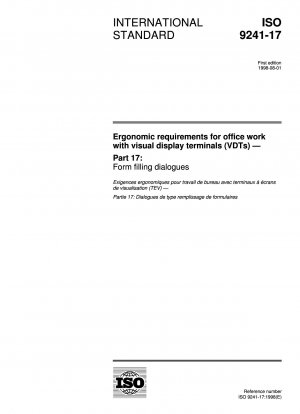ISO 9241-17:1998
Ergonomic requirements for office work with visual display terminals (VDTs) - Part 17: Form-filling dialogues
- Standard No.
- ISO 9241-17:1998
- Release Date
- 1998
- Published By
- International Organization for Standardization (ISO)
- Status
- Latest
- ISO 9241-17:1998
- Scope
- This part of ISO 9241 provides conditional recommendations on dialogue design, input design and output design for computer dialogues in which form filling and dialogue boxes are used to accomplish typical office tasks. Form filling dialogues are dialogues in which the user fills in, selects entries for, or modifies labelled fields on a "form" or a dialogue box presented by the system. Often the system then creates, or updates the database associated with the form. Form filling entries typically are in the form of typed input (abbreviations, or full names) or selections from available option lists. This part of ISO 9241 pertains to form filling dialogues generated through both VDT character-based and bit-mapped screen displays (often referred to as "GUIs") and input through keyboards and optional pointing devices (e.g. mice). In addition, this part includes the use of non-text methods for providing forms entries (e.g. list boxes) and pertains to dialogue boxes which utilize form filling dialogue techniques. It should be noted that some of the recommendations in this part of ISO 9241 are based on Western Language conventions. For other languages, the recommendations may need to be modified to fit the readability considerations inherent in these languages. These recommendations can be utilized throughout the development process (e.g., as guidance for designers during design, as a basis for heuristic evaluation, as guidance for usability testing) and in the procurement process. Interface design depends upon the task, the user, the environment, and the available technology. Consequently, this part of ISO 9241 cannot be applied without a knowledge of the design and use context of the interface and it is not intended to be used as a prescriptive set of rules to be applied in their entirety (see ISO 9241-11). Rather, it assumes that the designer has proper information available concerning task and user requirements and understands the use of available technology (this may require consultation with a qualified ergonomics professional as well as empirical testing with real users). The recommendations relate to the three major design components of user interfaces, i.e., dialogue, input, and output. Dialogue design determines the way in which a user is guided by the system to make inputs and influences the amount of control the user has over the dialogue. Form filling dialogues should be designed to support the user in his/her actual work without creating additional work caused by system peculiarities as well as enabling the user to become well-informed and to remain in control of the flow of work (also, see ISO 9241-10 which deals with dialogue principles). Dialogue design is covered in this part of ISO 9241 in terms of designing form filling structures, providing feedback mechanisms and providing appropriate navigation methods. Input design is concerned with how input devices can be applied to facilitate the entry and modification of form fields. One or more devices such as an alphanumeric keyboard, function keys, pointing devices and voice (other devices are not excluded) can be provided depending on the task at hand and dialogue requirements, as well as on individual preferences. This part of ISO 9241 provides conditional recommendations for text entry, choice entry, and control using various input devices.
ISO 9241-17:1998 history
- 1998 ISO 9241-17:1998 Ergonomic requirements for office work with visual display terminals (VDTs) - Part 17: Form-filling dialogues
